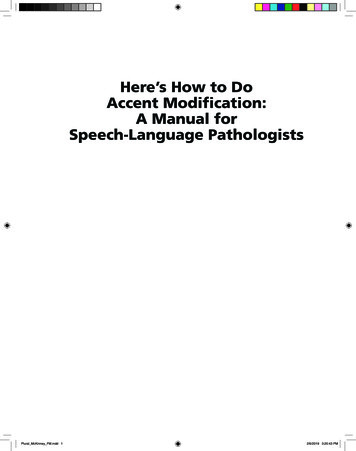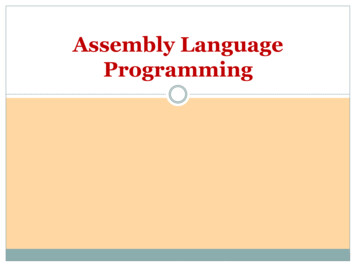
Transcription
Here’s How to DoAccent Modification:A Manual forSpeech-Language PathologistsPlural McKinney FM.indd 12/6/2019 3:20:43 PM
“Here’s How”Thomas Murry, PhDSeries EditorHere’s How to Do Therapy: Hands-On Core Skills in Speech-LanguagePathology, Second Edition by Debra M. Dwight, EdDHere’s How to Treat Dementia by Jennifer L. Loehr,MA, CCC-SLP and Megan L. Malone, MA, CCC-SLPHere’s How to Provide Intervention for Children with AutismSpectrum Disorder: A Balanced Approach by Catherine B. Zenko,MS, CCC-SLP and Michelle Peters Hite, MS, CCC-SLPHere’s How to Do Early Intervention for Speech and Language:Empowering Parents by Karyn Lewis Searcy, MA, CCC-SLPHere’s How to Do Stuttering Therapy by Gary J. Rentschler, PhDHere’s How Children Learn Speech and Language: A Text on DifferentLearning Strategies by Margo Kinzer Courter, MA, CCC-SLPHere’s How to Treat Childhood Apraxia of Speech, Second Editionby Margaret Fish, MS, CCC-SLPHere’s How to Teach Voice and Communication Skills toTransgender Women by Abbie Olszewski, PhD, CCC-SLP,Selah Sullivan, MS, CCC-SLP, and Adriano Cabral, MFAPlural McKinney FM.indd 22/6/2019 3:20:43 PM
Here’s How to DoAccent Modification:A Manual forSpeech-Language PathologistsRobert McKinney, MA, CCC-SLPPlural McKinney FM.indd 32/6/2019 3:20:49 PM
5521 Ruffin RoadSan Diego, CA 92123e-mail: information@pluralpublishing.comWeb site: http://www.pluralpublishing.comCopyright 2019 by Plural Publishing, Inc.Typeset in 11/15 Stone Informal by Achorn InternationalPrinted in the United States of America by Integrated Books InternationalAll rights, including that of translation, reserved. No part of this publication may bereproduced, stored in a retrieval system, or transmitted in any form or by any means,electronic, mechanical, recording, or otherwise, including photocopying, recording,taping, Web distribution, or information storage and retrieval systems without the priorwritten consent of the publisher.For permission to use material from this text, contact us byTelephone: (866) 758-7251Fax: (888) 758-7255e-mail: permissions@pluralpublishing.comEvery attempt has been made to contact the copyright holders for material originally printed inanother source. If any have been inadvertently overlooked, the publishers will gladly make thenecessary arrangements at the first opportunity.Library of Congress Cataloging-in-Publication DataNames: McKinney, Robert (Speech-language pathologist), author.Title: Here’s how to do accent modification : a manual for speech-languagepathologists / Robert McKinney.Description: San Diego, CA : Plural Publishing, [2019] Includesbibliographical references and index.Identifiers: LCCN 2018055066 ISBN 9781635500073 (alk. paper) ISBN 1635500079 (alk. paper)Subjects: MESH: Language Therapy—methods Language DevelopmentClassification: LCC RC423 NLM WL 340.3 DDC 616.85/5206—dc23LC record available at https://lccn.loc.gov/2018055066Plural McKinney FM.indd 42/6/2019 3:20:49 PM
ContentsIntroductionxiChapter 1. Accents 1Our Accents 1Native Accents 1The Critical Period 3Ultimate Attainment 4Actors and Spies 6Effective Communication 9Accentedness 10Nativeness Versus Intelligibility 11Intelligibility and Comprehensibility 12A Clear and Natural Accent 12Awareness, Training, and Counseling 14Our Role 16References 17Chapter 2. Accent Modification 19Who Provides Accent Modification? 19Teachers of English to Speakers of Other Languages 19Voice and Speech Trainers 22Speech-Language Pathologists 24Where SLPs Practice Accent Modification 27Private Practice 28University Programs 29Worksites 29How Does Accent Modification Work? 37Who Are Our Clients? 39Does Accent Modification Work? 41vPlural McKinney FM.indd 52/6/2019 3:20:49 PM
vi Here’s How to Do Accent Modification: A Manual for Speech-Language PathologistsEfficacy Studies 41Non-Native Clinicians 44A Note on Dialects 45References 46Chapter 3. Assessment 49Overview 49Purposes of Accent Assessments 50Determining Clients’ Goals 50Segmental Assessment 52Intelligibility Assessment 56Suprasegmental Assessment 57Diagnostic Passages 58Spontaneous Speech Sample 60Assessing Pragmatics 61Evaluating Through Listening and Writing 61Evaluating Language 62Assessment Packages 63Final 68Chapter 4. Segmentals Overview 83Working with Sounds 83Phonemes and Allophones 83International Phonetic Alphabet and Spelling 85Phonemic Awareness 86Principles of Segmental Training 88Basic Techniques 88Minimal Pairs 90Other Auditory Discrimination Activities 94Generalization 95Target Selection 98Contrastive Analysis 98Functional Load 99Other Factors in Target Selection 103References 103Appendices 105Chapter 5. Suprasegmentals Overview 109Patterns of Speech 109Rate 110Should Clients Slow Down? 110Measuring Rate 112Plural McKinney FM.indd 62/6/2019 3:20:49 PM
ContentsviiPausing and Mean Length of Run (MLR) 113Average Rate of Speech 113Intonation 114The Big Picture 114Typical Intonation Patterns 118End of a Statement 118Question Intonation 118List Intonation 119Choice Questions 119Tag Questions 120Emphasis 120Question Word Intonation 121Rhetorical s to Develop Intonation Awareness 122References 124Appendices 126Chapter 6. Consonants 137Working with Consonants 137Familiar Ground 137Classification of Consonants 137Consonants of the World 138Client Awareness 139The Basics 139Voicing 140Nasals, Liquids, and Approximants 141Problematic Phonemes 142Typical Targets 142American /ɹ/ 143The th /θ, ð/ 144The Post-Alveolar Affricates /ʧ, ʤ/ 146 The Remaining Approximants, /w, j, l/, and the GlottalFricative /h/ 146Allophones 147Natural Speech 147The Alveolar Tap 148The Nasal Tap 150Unreleased Stops 150The Glottal Stop 151Syllabic /n/ 151Nasal Plosion 152Plural McKinney FM.indd 72/6/2019 3:20:49 PM
viii Here’s How to Do Accent Modification: A Manual for Speech-Language Chapter 7. Vowels 169Introduction to Vowels 169Out of the Comfort Zone 169Vowel Space 169Developing Vowel Awareness 171Vowel Basics 172Shapes and Space 172Vowel Length 177Tense and Lax Vowels 178The Schwa and Reduced Vowels 178Gliding 180Roundedness and Lip Position 180Diphthongs 181Rhoticity, Nasality, Voicing 181Coarticulation 182American English and Other Dialects 183Typical Targets 184/i/ vs. /ɪ/ 184/eɪ/ vs. /ɛ/ 185/ʊ/ vs. /u/ 185/ɔ/ vs. /ɑ/ 186/ɑ/ vs. /æ/ 186/ɛ/ vs. /æ/ 187/ɑ/ vs. 2Chapter 8. Syllables and Stress 203The Syllable 203Building Blocks 203Syllable Structure 203Phonotactics 205Syllable Count 206Syllables and Vowels 208Syllables and Endings 208Non-Native Errors 208Regular Past Tense -ed 209The -s Ending 210Lexical Stress 211English Stress 211Stress Patterns 213Plural McKinney FM.indd 82/6/2019 3:20:49 PM
ContentsixMorphology and Stress 218Compound Nouns and Descriptive Phrases 219References 221Appendices 222Chapter 9. Prosody 231Phrasal Stress 231Language Rhythm 231Syllable Based versus Stress Based 231Content Words Versus Function Words 232Tonic Stress 235Reducing Modals and Auxiliaries 236Emphasis 238Shifting Focus 238Advanced Functions of Emphasis 240Training on Emphasis �� 247Plural McKinney FM.indd 9Chapter 10.Connected Speech 253Overview of Connected Speech 253Linking Consonants 253CV Linking 254Linking with /n/ 255Linking with /t/ 255Intervocalic Linking with Other Consonants 256CC Linking 257Extending Consonants 257Hold and Release 258The Glottal Stop 258Assimilation 258Pronoun Reduction 260The Rule of Three and Endings 261Elision 261Linking of the Regular Past 263Linking Vowels 263Putting It All Together 264References 265Appendices 266Chapter 11.Getting Started 275Getting More Training 275Additional Resources 278University Clinics 2822/6/2019 3:20:49 PM
x Here’s How to Do Accent Modification: A Manual for Speech-Language PathologistsStudent Clinicians 282The Accent and Communication Training Program at SDSU 283Group Work 288In Their Own Words 289Career eferences 293Appendices 294IndexPlural McKinney FM.indd 102972/6/2019 3:20:49 PM
Introduction“I’ve been working as a speech-language pathologist for several years now, but I’m interestedin changing it up a little and have been looking into getting involved in accent modification.I know it’s part of our scope of practice, but it’s a foreign area to me and I have no ideawhere to begin. I would like to take some trainings and buy some materials for help. Anytips on how or where to start? Any information would be greatly appreciated!”—AnonymousThose of us working in the world of accent modification have heard variations on thisquestion throughout our careers. I wrote this book to answer it. Here’s How to Do Accent Modification is designed primarily for speech-language pathologists (SLPs) looking to bridge thegap between the insights and techniques they have developed in their work with communicative disorders and the skills and knowledge that will help them excel with clients whosecommunication challenges are related to language differences. It is also aimed at graduateclinicians and supervisors who work on accents, and it provides a fresh perspective to thosewho come to the field with other backgrounds, such as teachers of English to speakers ofother languages, and voice and speech trainers. There is an emphasis on practical tips, techniques, and examples, and the PluralPlus companion website features additional resources,such as editable worksheets, sound files, and video clips.At the heart of the book is the understanding that accents are normal and natural,representing the wonderful linguistic diversity of our species. Unfortunately, when nonnative speakers have not achieved the degree of intelligibility and naturalness requiredfor effective communication in their target language, they may face significant barriersto personal and professional success. When clients reach out for help in overcoming thesehurdles, they often turn to professionals, and SLPs are well-equipped for the task. Thekey is to understand that although graduate training and clinical expertise provide SLPswith a solid foundation, it is their ethical obligation to attain the additional skills andknowledge necessary to produce results with this unique clientele. Fortunately this goal iswell within reach, and the hope is that this book will play a role in the future success ofmany SLPs and their clients.Chapter 1, “Accents,” lays a foundation by considering the nature of accents and whypeople have them. Although each of us has an accent, a non-native accent often presentssignificant challenges. Fortunately, non-native speakers who acquire a clear and naturalxiPlural McKinney FM.indd 112/6/2019 3:20:49 PM
xii Here’s How to Do Accent Modification: A Manual for Speech-Language Pathologistsaccent can overcome these obstacles and even communicate more effectively than nativespeakers of their new language. SLPs are well-suited to help them achieve this goal.Chapter 2, “Accent Modification,” addresses the practicalities and efficacy of accentmodification and discusses the professionals who provide it, along with their settings. Italso discusses the training and skills that SLPs bring to this field. This chapter introducesthe useful distinction between the segmental and suprasegmental features of phonologyand provides a look at the counseling aspect of accent training.Chapter 3, “Assessment,” reviews the principles involved in determining which areasof a client’s speech present the greatest barriers to communicative success. While manySLPs are uncertain about how to conduct second language phonological evaluations, thegoal of this chapter is to empower them to develop their own methods by adapting theideas and materials provided in this manual.Chapter 4, “Segmentals Overview,” looks at ways to develop clients’ phonemic awareness and addresses the principles involved in working with the individual sounds of thelanguage. There is an extensive review of techniques, such as minimal pairs, some practical ideas on promoting generalization, and an in-depth look at the process of targetselection.Chapter 5, “Suprasegmentals Overview,” focuses primarily on intonation and rate,since these two features can be addressed at any stage of second language phonologicalacquisition and form the foundation of much of the suprasegmental training that helpsclients produce natural sounding speech.Chapter 6, “Consonants,” outlines the consonant inventory of English and focuseson those which tend to be the most problematic. In keeping with the “clear and natural”approach advocated in the book, phonemes which tend to have a strong effect on intelligibility, as well as the allophones which can affect naturalness, are addressed.Chapter 7, “Vowels,” bridges the gaps between the theoretical knowledge about theEnglish vowel system that SLPs have from their courses in phonetics and phonology, andthe practical aspects of eliciting these sounds with non-native speaking clients. Whileit is relatively rare for SLPs to work with vowels in most other areas within our scope ofpractice, in accent modification it is both common and powerful.Chapter 8, “Syllables and Stress” returns to the suprasegmentals to examine severalfeatures of English that often prove troublesome for non-native speakers. Variations insyllable structure and lexical stress in the world’s languages make these aspects challenging, and clinicians often make significant gains when addressing them with clients.Chapter 9, “Prosody,” uses a narrow definition of this term to address suprasegmentals related to the rhythm and phrasing of English. This chapter also examines vowelreductions, which are key to producing natural speech, and emphasis, which is often agood starting point for work on more abstract features of intonation.Chapter 10, “Connected Speech,” discusses the elements of natural spontaneous oralcommunication and looks into features which are rarely addressed by SLPs in other fields,such as linking and elision. The goal is to help clients develop the ability to balance intelligibility and naturalness.Plural McKinney FM.indd 122/6/2019 3:20:49 PM
IntroductionxiiiChapter 11, “Getting Started,” begins with a discussion of the next steps SLPs can taketo excel in accent modification and provides resources on how to get started in privatepractice. There is also an in-depth section on the mechanics of a university-clinic accentmodification program and some words of advice from graduate students to their peers.The chapter ends with some thoughtful words from private practitioners concerning thechallenges and rewards of this incredible field.My personal journey has unfolded in the opposite direction of most SLPs working inaccent modification. I had earned an M.A. in Russian Studies and an M.A. in TeachingEnglish to Speakers of Other Languages (TESOL) before I became an SLP. In my 26-yearcareer teaching English to non-native speakers, I worked in six countries with clientsfrom over 80 nations, and this experience has informed my work at San Diego StateUniversity’s Accent and Communication Training (ACT) program, where I have had thepleasure of supervising many outstanding graduate clinicians. My personal connectionto accent comes from my experiences as a native speaker of English and non-nativespeaker of Hungarian, Russian, Spanish, German, and Portuguese. In the nearly 10 yearsof my adult life spent living abroad and communicating in other languages, I have hada glimpse of the challenges and emotions that often go hand-in-hand with soundingdifferent. Accents and languages are a part of my home as well; my wife, who is also apracticing SLP, is a native speaker of Hungarian, and my son is a bilingual speaker ofHungarian and English. A love of languages, accents, and cultures brought me to thisfield, and if it brought you here as well, I know you will be rewarded by working with thisamazing group of clients.Plural McKinney FM.indd 132/6/2019 3:20:49 PM
Plural McKinney FM.indd 142/6/2019 3:20:49 PM
Dedicated to Szilvi and Mark, whose accents lie in my heart.Plural McKinney FM.indd 152/6/2019 3:20:49 PM
Plural McKinney FM.indd 162/6/2019 3:20:49 PM
CHAPTER1AccentsOur AccentsWe each have an accent. We overlook this universal truth because we consider our ownway of speaking as normal and speech that differs as accented. In the words of PeterLadefoged, “an accent is always what the other person has.” (Ladefoged & Disner, 2012,p. 27) This is especially true if we speak the “standard” or “prestige” dialect of a language.Upon examination, this reasoning collapses quickly. It is important to understand thateach one of us has an accent, and we sometimes use the word idiolect to highlight the factthat just as our voices are unique, so are our individual patterns of speaking. The waywe speak is who we are. Native speakers are conjoined by the commonalities of their in dividual accents, creating a powerful sense of community. Yet for non-native speakers,a way of speaking that differs can pose significant challenges. The phonology of eachlanguage is unique, and if a non-native speaker is unable to produce particular soundsin the new language, miscommunication may result. In addition, speech produced withpatterns dis similar to a target language may cause listeners to focus on the delivery andnot the message. Many non-native speakers devote time and energy to mastering the pro nunciation of a target language because they believe that changing the way they speakcan help them attain the personal and professional success they desire. Accent modifica tion is an elective service that assists clients in achieving their goals, and speech-languagepathologists (SLPs) are especially well-suited to provide it.Native AccentsAccents and attitudes about them represent incredibly complex phenomena, and theconcept of a native accent is an important starting point in any discussion of secondlanguage phonology. The word accent tends to be interpreted in two different ways.Crystal (2008, p. 3) defined accent broadly as the “features of pronunciation which identify1Plural McKinney Ch01.indd 12/6/2019 3:26:47 PM
2 Here’s How to Do Accent Modification: A Manual for Speech-Language Pathologistswhere a person is from, regionally, and socially,” but Scovel (1969, p. 38) defined accentin the narrower sense as “phonological cues, either segmental or suprasegmental, whichidentify the speaker as a non-native user of the language.” According to the first defini tion, everyone has an accent, but by the second definition, some of us do and some of usdo not, and this division of the world into native and non-native speakers has profoundimplications. Subtle differences alone can set the non-native apart even when there isno effect on communication. From a very early age, native speakers of a language areable to identify non-natives quickly, and this has a profound effect on group identity thatcannot be underestimated. When non-native speakers open their mouths they can beinstantaneously categorized as “other.”The word native is derived from the Latin verb nāscı̄ stemming from the proto IndoEuropean root *gene-, meaning to give birth. Thus the use of the term “native speaker”implies that speakers born into a language will speak it differently than those who arenot. The association with birth itself is imprecise; it is universally understood that humanscan acquire the mother tongue they were born into and learn to sound exactly like anative speaker in a second language at a later point in life. The key question is whetherthis is possible throughout the lifespan or only up to a certain age. As a thought ex periment, I ask my clients to imagine a 6-year-old girl from their country who is adoptedby a monolingual English-speaking family and raised in the United States. When I askwhether she would have a native-sounding accent in her new language at the age of 20,they are universally certain she would. I then ask them to imagine a 20-year-old womanfrom their country who marries an American and moves to this country. She has someknowledge of English when she arrives and then spends 20 years speaking English toher husband, family, co-workers, and friends. When I ask my clients whether she wouldsound like a native or non-native by the age of 40, they generally say she will sound likea non-native, but in almost every group of clients, at least one insists she might be ableto acquire a native accent. Is there evidence to support this?This book argues that non-native accents are both natural and wonderful, and thatthey do not inherently interfere with communication. However, it is important to estab lish at the outset whether adult learners of a second language can acquire accents thatsound exactly like a native speaker. This question has been the subject of considerableresearch and debate, but it is not an academic exercise because it has profound implica tions for accent modification. When non-native speakers choose to modify their accentsit is common for them to aim for native-sounding speech as the ultimate level of success.Derwing (2003), asked one hundred adult second language learners in Canada to ratethe degree to which they agreed with the following statement on a 7-point scale (with 7 rep resenting “I strongly agree” and 1 representing “I strongly disagree”): “If it were pos sible, I would pronounce English like a native speaker.” Ninety-five out of one hundredresponded affirmatively, with 82% rating their agreement as a 1 and 13% selecting 2.Many books and websites promote the idea that non-natives can lose their accent asa central selling point to attract customers. In addition, many natives tend to considerany differences between a learner’s speech and the native model as imperfections thatshould be corrected, and it is unfair to those acquiring a second language to pretendPlural McKinney Ch01.indd 22/6/2019 3:26:47 PM
Accents3otherwise even if we could eliminate these unfortunate biases in a perfect world. If at taining a native accent as an adult can be reliably achieved, SLPs’ focus should be ondetermining exactly how to produce that result. On the other hand, if achieving this goalis extremely rare (if not entirely impossible) then disappointment is bound to follow, andwe are setting our clients up for failure. In reality, the research has shown that for thosewho acquire a language at some point during or after adolescence, having an accent isexpected. Clients should be encouraged to understand that they are normal; it is entirelynatural to have an accent. The goal of accent modification is to help our clients commu nicate effectively, which is something SLPs are well-trained to do, and not to make themindistinguishable from native speakers of the target language, which is unrealistic andunnecessary. Nevertheless, because it is so widely believed by non-natives and nativesalike that adults can “lose” their accents, this notion merits a more detailed investigation,and it is always worth exploring with clients before training begins.The Critical PeriodThroughout the ages, adults have envied the advantages children enjoy in learning asecond language, but serious study of children’s relative facility dates only to the secondhalf of the twentieth century. Balari and Lorenzo (2015) cite Juan Huarte de San Juan, apioneer in cognitive psychology, as stating in 1575 that, “children, as already observedby Aristotle, learn any single language better than older men, in spite of the latter beingmore rational. And no one needs to remember us this, for common experience amplyshows it, as when a thirty or forty years old native from Biscay [Basque Country] comesto Castile, and he never learns the Romance language, but if he is a child, within twoor three years he looks as if born in Toledo.” The modern era of research became activeby the 1960s, picked up steam in the 1990s, and continues to the present day. Penfieldand Roberts (1959) linked children’s second language abilities to ongoing neuroplasticity,which is subsequently diminished through maturation. Lenneberg (1967, p. 176) was thefirst to conclude that “foreign accents cannot be overcome easily after puberty,” highlight ing the uniqueness of phonology in second language acquisition and demarcating theboundaries of attainment on par with native speakers. This critical period hypothesis (CPH)posits a developmental point after which biological changes preclude second languagelearners from achieving nativelike competence in a language. Scovel (1969) attributedthe inability to acquire nativelike proficiency after puberty to neuroplasticity, but others,including Patkowski (1990), sought to disassociate lateralization from plasticity. Long(1990) offered decreasing myelination during development as an alternative mechanismto explain the change in plasticity. Birdsong (2018) reports that: “more recent research ers have put forth other neurobiological explanations for plasticity deficits over age. Forexample, on a ‘use it then lose’ it model, after adolescence the circuitry that is requiredfor language learning is dismantled because in adulthood there remains no selectionpressure on humans to keep learning languages.”Several different strands of research related to CPH have emerged. Much researchhas focused on language acquisition in general, with a great deal of attention paid toPlural McKinney Ch01.indd 32/6/2019 3:26:47 PM
4 Here’s How to Do Accent Modification: A Manual for Speech-Language Pathologistssecond language acquisition, and specifically, second language phonology, because itappears to follow different acquisition patterns than other aspects of language. Manystudies have attempted to define this critical period by identifying its ages of onset andoffset. In other words, what is the earliest age a child might be immersed in a secondlanguage and speak with a non-native accent and what is the latest age someone canacquire a language and sound like a native? Studies have also addressed the linearityof the critical period and whether it should be defined as a sensitive period (SP) to avoidfalsification by exceptional learners. After analyzing previous research on the issue, Long(1990, p. 274) lowered traditional estimates for the age of onset, claiming that “exposureneeds to occur before age 6 to guarantee that L2 phonology can become nativelike.” Hebased this conclusion on several long-term studies, including Oyama’s (1976) exami nation of sixty Italian immigrants to the United States. In that study, several childrenwith an age of arrival between six and ten were found to have an accent in English,despite lengthy periods of residence in their adopted country. While Lenneberg (1967)cited puberty as the point after which non-native speakers could not achieve accent freespeech, despite the presumably wide variation at which this process occurs in individuals,Scovel (1969) specified age twelve as the age of offset, and this number has been usedconsistently as a benchmark in studies of second language acquisition. Long concurredthat age twelve represented the upper limit of the critical period, and he identified theage of six as the age of onset. More recently, Granena and Long (2013, p. 336) reaf firmed this timeframe, stating: “. . . the evidence from this study, plus from previousresearch by others, leads to the conclusion that there is an SP for phonology, its offsetbeginning at age six, and possibly earlier . . . probably closing by age 12.” It is importantto note that there is no reason to believe that any specific age will ever be identified,so these timeframes are generalizations. As Munro and Mann (2005, p. 337) point out:“[no] model of an age–accent connection should ever hope to claim ‘before age X, aperson is guaranteed to develop a native accent and, after age Y, a foreign accent isunavoidable’” On balance, however, the preponderance of evidence indicates that mostnon-native speakers will speak with a foreign accent if they are immersed in a secondlanguage after about the age of twelve, although the age of offset of the sensitive periodfor some speakers may come a few years later. The individual variations found betweenthese ages lend credence to the notion of a sensitive period as opposed to a criticalperiod.Ultimate AttainmentThe relevance of the critical period to accent modification is clear—it is natural for adultsto have accents. Many factors can affect a non-native accent. Some may be within thecontrol of the speaker, such as motivation, amount of practice, formal study of the lan guage, and length of residence in a country where the language is spoken; others arebeyond the speaker’s control, such as native language or linguistic aptitude. Nevertheless,if we control for all of these factors, the most significant variable is still the age of immer sion in the target language environment.Plural McKinney Ch01.indd 42/6/2019 3:26:47 PM
Accents5If we end the discussion by agreeing that the age at which someone is immersed in aforeign language is strongly predictive of whether that person will speak with a native ornon-native accent, then we miss one crucial point that is inextricably tied to the world ofaccent modification: what can an adult learner ultimately attain in terms of a nativelikeaccent? In other words, is it ever possible for an adult learner to speak another languagewith a native accent? There is strong evidence suggesting that the answer is no. Despitethis fact, many non-native speakers strive to sou
American English and Other Dialects 183 . and provides a look at the counseling aspect of accent training. Chapter 3, “Assessment,” reviews the principles involved in determining which areas of a client’s speech present t











